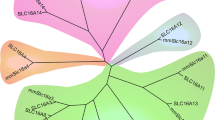Abstract
Neurons are known to accumulate l-carnitine—a compound necessary for transfer of acyl moieties through biological membranes, apart from very low β-oxidation of fatty acids in adult brain. Present study demonstrates expression of octn2 and octn3 genes coding high affinity carnitine transporters, as well as presence of both proteins in neurons obtained from suckling and adult rats, and also in mouse transformed neural cells. Measurements of carnitine transport show activity of both transporters in neural cells, pointing to their importance in physiological processes other than β-oxidation.



Similar content being viewed by others
References
Kerner J, Hoppel C (2000) Fatty acid import into mitochondria. Biochim Biophys Acta 1486:1–17
Warshaw JB, Terry ML (1976) Cellular energy metabolism during fetal development. VI. Fatty acid oxidation by developing brain. Dev Biol 52:161–166
Ebert D, Haller RG, Walton ME (2003) Energy contribution of octanoate to intact rat brain metabolism measured by 13C nuclear magnetic resonance spectroscopy. J Neurosci 23:5928–5935
Virmani MA, Conti R, Spadoni A et al (1994) l-Carnitine uptake into primary rat cortical cultures: interaction with GABA. Brain Res Mol Brain Res 25:105–112
Wawrzeńczyk A, Nałęcz KA, Nałęcz MJ (1995) Effect of gamma-aminobutyric acid on the carnitine metabolism in neural cells. Biochem Biophys Res Commun 213:383–388
Wawrzeńczyk A, Sacher A, Mac M et al (2001) Transport of l-carnitine in isolated cerebral cortex neurons. Eur J Biochem 268:2091–2098
Tamai I, Ohashi R, Nezu J et al (1998) Molecular and functional identification of sodium ion-dependent, high affinity human carnitine transporter OCTN2. J Biol Chem 273:20378–20382
Tamai I, Ohashi R, Nezu JI et al (2000) Molecular and functional characterization of organic cation/carnitine transporter family in mice. J Biol Chem 275:40064–40072
Gründemann D, Harlfinger S, Golz S et al (2005) Discovery of the ergothioneine transporter. Proc Natl Acad Sci USA 102:5256–5261
Januszewicz E, Pająk B, Gajkowska B et al (2009) Organic cation/carnitine transporter OCTN3 is present in astrocytes and is up-regulated by peroxisome proliferators-activator receptor agonist. Int J Biochem Cell Biol 41:2599–2609
Lamhonwah AM, Ackerley CA, Tilups A et al (2005) OCTN3 is a mammalian peroxisomal membrane carnitine transporter. Biochem Biophys Res Commun 338:1966–1972
Wu X, Huang W, Prasad PD et al (1999) Functional characteristics and tissue distribution pattern of organic cation transporter 2 (OCTN2), an organic cation/carnitine transporter. J Pharmacol Exp Ther 290:1482–1492
Lamhonwah AM, Hawkins CE, Tam C et al (2008) Expression patterns of the organic cation/carnitine transporter family in adult murine brain. Brain Dev 30:31–42
Ramsay RR (2000) The carnitine acyltransferases: modulators of acyl-CoA-dependent reactions. Biochem Soc Trans 28:182–186
Kwok B, Yamauchi A, Rajesan R et al (2006) Carnitine/xenobiotics transporters in the human mammary gland epithelia, MCF12A. Am J Physiol Regul Integr Comp Physiol 290:R793–R802
Arduini A, Mancinelli G, Radatti GL et al (1992) Role of carnitine and carnitine palmitoyltransferase as integral components of the pathway for membrane phospholipid fatty acid turnover in intact human erythrocytes. J Biol Chem 267:12673–12681
Arduini A, Denisova N, Virmani A et al (1994) Evidence for the involvement of carnitine-dependent long-chain acyltransferases in neuronal triglyceride and phospholipid fatty acid turnover. J Neurochem 62:1530–1538
Juliet PA, Balasubramaniam D, Balasubramaniam N et al (2003) Carnitine: a neuromodulator in aged rats. J Gerontol A Biol Sci Med Sci 58:970–974
Luci S, Geissler S, Konig B et al (2006) PPARalpha agonists up-regulate organic cation transporters in rat liver cells. Biochem Biophys Res Commun 350:704–708
Rodriguez CM, Labus JC, Hinton BT (2002) Organic cation/carnitine transporter, OCTN2, is differentially expressed in the adult rat epididymis. Biol Reprod 67:314–319
Andjus PR, Stevic-Marinkovic Z, Cherubini E (1997) Immunoglobulins from motoneurone disease patients enhance glutamate release from rat hippocampal neurones in culture. J Physiol 504:103–112
Brewer GJ, Torricelli JR (2007) Isolation and culture of adult neurons and neurospheres. Nat Protoc 2:1490–1498
Nałęcz KA, Korzon D, Wawrzeńczyk A et al (1995) Transport of carnitine in neuroblastoma NB-2a cells. Arch Biochem Biophys 322:214–220
Wagner CA, Lukewille U, Kaltenbach S et al (2000) Functional and pharmacological characterization of human Na(+)-carnitine cotransporter hOCTN2. Am J Physiol Renal Physiol 279:F584–F591
Todesco L, Bur D, Brooks H et al (2008) Pharmacological manipulation of l-carnitine transport into L6 cells with stable overexpression of human OCTN2. Cell Mol Life Sci 65:1596–1608
Inazu M, Takeda H, Maehara K et al (2006) Functional expression of the organic cation/carnitine transporter 2 in rat astrocytes. J Neurochem 97:424–434
Miecz D, Januszewicz E, Czeredys M et al (2008) Localization of organic cation/carnitine transporter (OCTN2) in cells forming the blood-brain barrier. J Neurochem 104:113–123
Kamińska J, Nałęcz KA, Azzi A et al (1993) Purification of carnitine carrier from rat brain mitochondria. Biochem Mol Biol Int 29:999–1007
Hannuniemi R, Kontro P (1988) l-Carnitine uptake by mouse brain synaptosomal preparations: competitive inhibition by GABA. Neurochem Res 13:317–323
Wawrzeńczyk A, Nałęcz KA, Nałęcz MJ (1995) Effect of externally added carnitine on the synthesis of acetylcholine in rat cerebral cortex cells. Neurochem Int 26:635–641
Nałęcz KA, Szczepankowska D, Czeredys M et al (2007) Palmitoylcarnitine regulates esterification of lipids and promotes palmitoylation of GAP-43. FEBS Lett 581:3950–3954
Shinawi M, Gruener N, Lerner A (1998) CSF levels of carnitine in children with meningitis, neurologic disorders, acute gastroenteritis, and seizure. Neurology 50:1869–1871
Jones LL, McDonald DA, Borum PR (2010) Acylcarnitines: role in brain. Prog Lipid Res 49:61–75
Ohashi R, Tamai I, Yabuuchi H et al (1999) Na(+)-dependent carnitine transport by organic cation transporter (OCTN2): its pharmacological and toxicological relevance. J Pharmacol Exp Ther 291:778–784
Ganapathy ME, Huang W, Rajan DP et al (2000) Beta-lactam antibiotics as substrates for OCTN2, an organic cation/carnitine transporter. J Biol Chem 275:1699–1707
Zammit VA, Ramsay RR, Bonomini M et al (2009) Carnitine, mitochondrial function and therapy. Adv Drug Deliv Rev 61:1353–1362
Acknowledgments
This work was financed by grants 0660/PO1/2006/30 and 0413/B/PO1/36 from the Polish Ministry of Science and Higher Education and statutory funds of the Nencki Institute.
Author information
Authors and Affiliations
Corresponding author
Rights and permissions
About this article
Cite this article
Januszewicz, E., Bekisz, M., Mozrzymas, J.W. et al. High Affinity Carnitine Transporters from OCTN Family in Neural Cells. Neurochem Res 35, 743–748 (2010). https://doi.org/10.1007/s11064-010-0131-5
Accepted:
Published:
Issue Date:
DOI: https://doi.org/10.1007/s11064-010-0131-5




